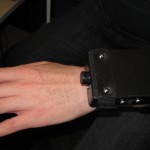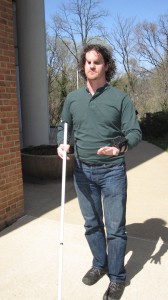Article by Joel Zimba, Special Projects Coordinator, MDTAP
Some months back there was an announcement of a haptic SONAR device called Tacit.
It is a DIY sort of project developed by Grathio Labs. The schematic along with code for the micro-controller was posted on the inventor’s website. I wrote an article on the Assistive Technology Blog about Tacit and how its approach differed from that of similar devices. 
I finally have a prototype device, which was constructed by two engineers from the University of Maryland Baltimore Campus. There were several challenges involved in the initial development, including some inconsistencies in the original schematics as well as some unexpected hardware issues. The result is a scaled-down version which is a great proof-of-concept and a first step toward a usable device.
The current incarnation is built around a standard plastic project box.
The two ultrasonic sensors working in parallax have been reduced to 1, and the corresponding feedback motors have been similarly halved. Two strips of Velcro attach the device to the back of the wrist. A pin connected to the motor moves to a greater or lesser degree depending on object proximity.
The idea is that as the sound waves bounce off of an object, the time it takes to receive the echo can be used to calculate the distance between the wearer and the object. The sampling rate of 6 readings per second sounds very fast, but an error checking algorithm reduces the number of usable samples. The feedback effect is analogous to stop action video.
In practice, I had to walk quite slowly to clearly scan across from right to left and get back any reliable information. Large objects  and known landmarks were the easiest for me to locate, while irregularly shaped things, such as trees and cars proved more difficult especially depending upon the angle and height of the sensor. One way in which I was very successful was navigating a known surface from a greater distance. For example, I could walk down the middle of a sidewalk with the walls of buildings on one side of me. By angling the device toward the wall at a 45 degree angle, I could tell from about ten feet away when there was an opening in the wall. While this of course can also be done with a standard straight cane, the distances involved are much greater.
and known landmarks were the easiest for me to locate, while irregularly shaped things, such as trees and cars proved more difficult especially depending upon the angle and height of the sensor. One way in which I was very successful was navigating a known surface from a greater distance. For example, I could walk down the middle of a sidewalk with the walls of buildings on one side of me. By angling the device toward the wall at a 45 degree angle, I could tell from about ten feet away when there was an opening in the wall. While this of course can also be done with a standard straight cane, the distances involved are much greater.
While there are several drawbacks to the current prototype, I can see how this could be made into a very useful mobility aid. Adding the second ultrasonic sensor and feedback motor would greatly increase my ability to judge the size, shape and location of objects. Of course miniaturization and overall performance are a given once the basic principles have been worked out. Stay tuned to see how this exciting project develops.